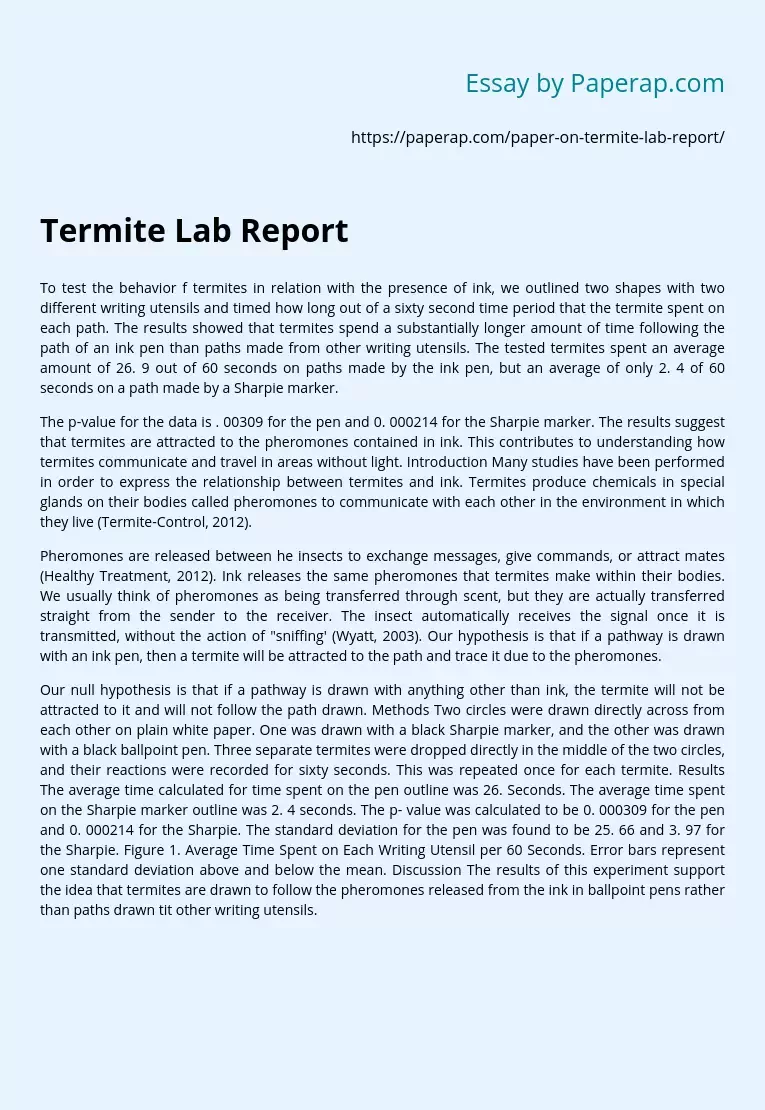Termite Lab Report
To test the behavior f termites in relation with the presence of ink, we outlined two shapes with two different writing utensils and timed how long out of a sixty second time period that the termite spent on each path. The results showed that termites spend a substantially longer amount of time following the path of an ink pen than paths made from other writing utensils. The tested termites spent an average amount of 26. 9 out of 60 seconds on paths made by the ink pen, but an average of only 2.
4 of 60 seconds on a path made by a Sharpie marker.
The p-value for the data is . 00309 for the pen and 0. 000214 for the Sharpie marker. The results suggest that termites are attracted to the pheromones contained in ink. This contributes to understanding how termites communicate and travel in areas without light. Introduction Many studies have been performed in order to express the relationship between termites and ink. Termites produce chemicals in special glands on their bodies called pheromones to communicate with each other in the environment in which they live (Termite-Control, 2012).
Pheromones are released between he insects to exchange messages, give commands, or attract mates (Healthy Treatment, 2012). Ink releases the same pheromones that termites make within their bodies. We usually think of pheromones as being transferred through scent, but they are actually transferred straight from the sender to the receiver. The insect automatically receives the signal once it is transmitted, without the action of “sniffing’ (Wyatt, 2003). Our hypothesis is that if a pathway is drawn with an ink pen, then a termite will be attracted to the path and trace it due to the pheromones.
Our null hypothesis is that if a pathway is drawn with anything other than ink, the termite will not be attracted to it and will not follow the path drawn. Methods Two circles were drawn directly across from each other on plain white paper. One was drawn with a black Sharpie marker, and the other was drawn with a black ballpoint pen. Three separate termites were dropped directly in the middle of the two circles, and their reactions were recorded for sixty seconds. This was repeated once for each termite. Results The average time calculated for time spent on the pen outline was 26. Seconds. The average time spent on the Sharpie marker outline was 2. 4 seconds. The p- value was calculated to be 0. 000309 for the pen and 0. 000214 for the Sharpie. The standard deviation for the pen was found to be 25. 66 and 3. 97 for the Sharpie. Figure 1. Average Time Spent on Each Writing Utensil per 60 Seconds. Error bars represent one standard deviation above and below the mean. Discussion The results of this experiment support the idea that termites are drawn to follow the pheromones released from the ink in ballpoint pens rather than paths drawn tit other writing utensils.
The data collected shows that the majority of the termites spent a majority of the timed sixty seconds tracing the outline of the pen as opposed to the outline of the Sharpie marker. The ink released from the Sharpie marker does not release the pheromones that termites are attracted to. The main limitation of the experiment was that the termites were not in their natural environment; they were placed in the light. Future experiments could be done in black paper or in the dark to see how termites would react when in their natural environment.
Termite Lab Report. (2018, Jun 15). Retrieved from https://paperap.com/paper-on-termite-lab-report/

